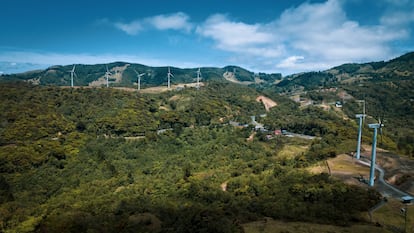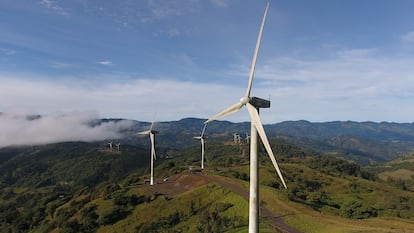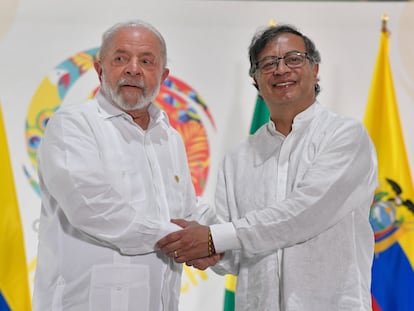Costa Rica’s green energy miracle is at a critical juncture
The country generates 99% of its electricity from renewables, but is challenged by drought and the government’s growing interest in fossil fuels


Only a few countries have developed an electricity grid powered mostly by renewable sources. Surprisingly, Costa Rica is one of them. For years, Costa Rica has relied on clean energy for up to 99% of its electricity, putting it in the league of innovative countries like Iceland, Norway and New Zealand. What sets Costa Rica apart is that it’s a less developed nation with a much smaller economy. The Costa Rican example shows how focused public policies can reduce reliance on fossil fuels and achieve energy autonomy. However, challenges remain, especially with climate change and a government shifting its focus back to fossil fuels. Costa Rica’s green energy miracle is at a critical juncture.
According to the National Electricity Control Center, Costa Rica’s renewable energy generation decreased from 99% in 2021 to 98% in 2022. It is estimated to be between 92% and 95% in 2023. This decline is primarily due to a drought, as 67% of the country’s renewable energy comes from hydroelectric plants (with the rest from geothermal, biomass, wind and solar energy). The lack of rainfall, despite an eight-month rainy season, required the use of fossil fuels to power the thermal plants.
“Last year was one of the most difficult in recent decades. We had our driest September ever, and record high temperatures in May and July. Electricity demand also grew by over 5%,” said Roberto Quirós, electricity manager for the Costa Rican Electricity Institute (ICE), the state-owned electrical and telecommunications services company. In previous years, Costa Rica achieved energy independence and powered numerous homes and businesses with clean energy, unaffected by global geopolitical events. This allowed the country to maintain stable energy prices, even during the increase in costs caused by the war in Ukraine.
Hydroelectric sources give way to wind turbines
Costa Rica has a long history of embracing renewable energy. In 1884, San José, the capital, became the third fully electrified city in the world after New York and Paris. Initially, hydroelectricity was the primary source of energy, but it remained under private ownership for many years. It wasn’t until the 1950s that energy generation was nationalized with the establishment of ICE.
Édgar Gutiérrez, former Minister of Environment and Energy (2014-2018) and a retired professor at the University of Costa Rica, tells EL PAÍS that in the late 1940s, the governing junta (the country had recently emerged from a civil war in 1948) created ICE in 1949. The purpose was to capitalize on the ample water sources for energy generation. “That made a huge difference for the country. They starting building hydroelectric plants and bringing electricity to every corner of the nation,” said Gutiérrez. Costa Rica later began to gradually diversify its energy production. “We exploited our geothermal sources, but when greenhouse gases became a concern, ICE began to focus on wind energy.”
As the population has grown, the demand for energy has increased. To meet this demand, ICE has allowed private companies to build and operate power plants through concessions. Since 2000, many energy projects have been completed, with wind energy being particularly noteworthy. These initiatives have enabled the country to achieve high levels of clean energy production.
Coopesantos, a well-known success story, manages a wind farm in the south of San José province. The objective of this cooperative, led by general manager Mario Solís, was to provide energy for development of the country’s rural areas.

Coopesantos now provides energy to approximately 53,000 people across an area of about 500 square miles (1,300 square kilometers). Solís says this clean energy not only offers electricity rate stability but also helps families cope with the rising cost of living. Between 2016 and 2023, while the general cost of living in Costa Rica increased by around 17%, energy rates actually decreased in nominal prices.
Erick Rojas, the vice president of the Chamber of Energy Distribution and Telecommunications Companies (CEDET), states that energy prices in Costa Rica are currently lower than those in Europe, the United States and the rest of Central America. Costa Rica also exports a portion of its energy to neighboring countries.
Drought, diversification and the looming shadow of hydrocarbons
President Carlos Alvarado (2018-2022) proposed a ban on oil and natural gas exploitation, but it has remained mired in Congress ever since. President Rodrigo Chaves has expressed interest in exploring the country’s natural gas reserves, although the size of these reserves has not thoroughly studied. His initiative contradicts decades of public policies that made Costa Rica an environmental leader.
Carlos Rodríguez, former Minister of Environment and Energy and current executive president of the Global Environment Fund (GEF), proudly highlights Costa Rica’s environmental reputation. The country gained recognition in the 1990s, with the establishment of the Ministry of Environment and Energy in 1995. Since then, Costa Rica has showcased its environmental achievements on the international stage. ““This image was earned through consistency,” said Rodríguez, who has 25 years of experience in the ministry since its creation. Rodríguez says this reputation even led former German Chancellor Angela Merkel to invite then-President Alvarado in 2019 to present his decarbonization plan.
“Most energy ministers on this planet seem to only focus on oil. It will be very hard to achieve the Paris [climate] agreement targets when we have rich governments that believe oil is the solution to the crisis,” said Rodríguez. Costa Rica’s pivotal moment was the consolidation of the Environment and Energy ministries into a single portfolio, unlike most governments that separate these areas. “Energy, mining, biodiversity, seas, water – we put it all together. That gave us a much better planning capacity than other countries.”
Rodríguez believes that planning is now one of country’s weak points because of the stubborn focus on large hydroelectric plants. “These plants are not only expensive, but they’re also inefficient and harm nature and the livelihoods of farmers. What we really need is to empower people to produce their own electricity using solar panels. It’s all about embracing a future of self-production and consumption, rather than sticking to the status quo.”

Andrea Meza, who succeeded Rodríguez as Minister of Environment and Energy (2020-2022), now serves as Deputy Executive Secretary of the United Nations Convention to Combat Desertification. “The drought’s impact on hydroelectric plants this year highlights the need to have a highly diversified electricity grid,” she said.
ICE’s Roberto Quirós argues that the debate should not be oversimplified. “We cannot over-install solar panels because that ultimately translates into higher rates.” Quirós is seeking a better balance. “Hydroelectric power is highly effective during periods of abundant water, while solar power excels in different circumstances. By leveraging these and other resources, we aim to meet the nation’s energy needs.”
Despite the challenges faced in 2023, Quirós says the country still maintains a high level of renewable energy in its grid. However, he predicts this year and the next will be difficult due to inadequate institutional planning. “Decisions that should have been made before 2022 didn’t happen and now we have to deal with the consequences.”
New ventures
The former ministers and suppliers all agree on the urgent need to diversify energy sources. However, Meza believes that planning should extend beyond that and address other areas where Costa Rica lags, like transportation. According to a January 2023 study by the Costa Rica Technological Institute, the country ranks third in Latin America for private vehicle density – 231 cars per 1,000 inhabitants. Vehicles consume 35% of Costa Rica’s fossil fuel supply.
The growing number of fossil fuel-powered vehicles, drought, hydroelectricity dependence, and President Rodrigo Chaves’s natural gas exploitation experimentation pose challenges to a country that champions environmentalism. However, Meza (recipient of the 2021 Earthshot Prize for environmental leadership) believes that the country has demonstrated an ability to make major changes in times of crisis. In the 1980s, Costa Rica had only 30% forest cover, mainly because of agricultural industry growth. However, through a series of public policies, the country has successfully increased its forest cover to over 52%.
“For me, that’s a really beautiful story. Because if nothing had been done, the whole country would have been destroyed. But our leaders adjusted, applied a clear policy, and we now see the impacts 20 years later,” said Meza. To sustain its environmental leadership, Costa Rica must once again demonstrate its ability to embrace transformation.
Sign up for our weekly newsletter to get more English-language news coverage from EL PAÍS USA Edition
Tu suscripción se está usando en otro dispositivo
¿Quieres añadir otro usuario a tu suscripción?
Si continúas leyendo en este dispositivo, no se podrá leer en el otro.
FlechaTu suscripción se está usando en otro dispositivo y solo puedes acceder a EL PAÍS desde un dispositivo a la vez.
Si quieres compartir tu cuenta, cambia tu suscripción a la modalidad Premium, así podrás añadir otro usuario. Cada uno accederá con su propia cuenta de email, lo que os permitirá personalizar vuestra experiencia en EL PAÍS.
¿Tienes una suscripción de empresa? Accede aquí para contratar más cuentas.
En el caso de no saber quién está usando tu cuenta, te recomendamos cambiar tu contraseña aquí.
Si decides continuar compartiendo tu cuenta, este mensaje se mostrará en tu dispositivo y en el de la otra persona que está usando tu cuenta de forma indefinida, afectando a tu experiencia de lectura. Puedes consultar aquí los términos y condiciones de la suscripción digital.
More information
Últimas noticias
Maduro pleads not guilty before the federal court in New York: ‘I am still the president of Venezuela’
A new test can detect Alzheimer’s from a finger prick
UN team enters Sudanese city of El Fasher after paramilitary massacre: ‘It’s like a ghost town’
A recipe for resistance: Indigenous peoples politicize their struggles from the kitchen
Most viewed
- Gilles Lipovetsky: ‘If you want to live better and fall in love, take Prozac, don’t look to philosophy’
- Alain Aspect, Nobel laureate in physics: ‘Einstein was so smart that he would have had to recognize quantum entanglement’
- Alvin Hellerstein, a 92-year-old judge appointed by Bill Clinton, to preside over Maduro’s trial in New York
- Maduro’s downfall puts China’s relationship with Venezuela to the test
- Why oil has been at the center of Venezuela-US conflicts for decades










































